Discover the top 20 tips for portion control to help you lose weight (without feeling hungry).
Portion control doesn’t always come naturally. Whether you are trying to lose weight or just want to focus on eating a healthy diet without feeling hungry all the time.
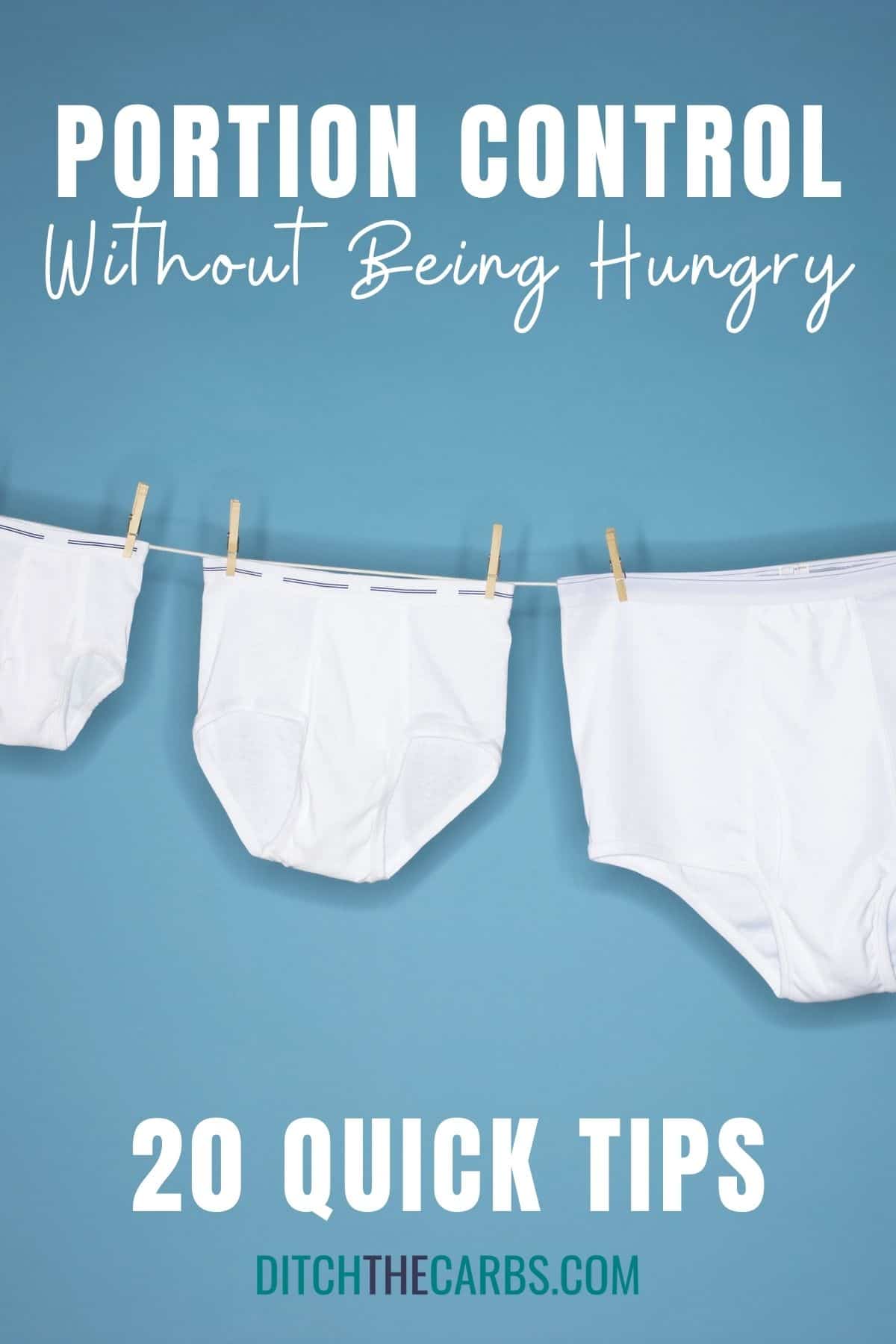
What is a serving size and portion size? – it can be confusing, especially if you want to prevent overeating and lose weight without starving.
Portion size vs serving size
There is a subtle difference between serving size and portion size.
Are you ready to lose weight and heal your body for life (without dieting, drugs, or making yourself miserable)?

Our free on-demand video training will walk you through how to make this THE year you set health goals…and keep them.
Portion size is how much you choose to eat. It is completely under your control and is steadily increasing each year as fast food joints and restaurants increase the size of their meals.
Serving size is a standardized amount of food. 1 slice, 1 cake, 100g, 1 cup. This standard can be set by the manufacturer or just generally accepted.
For example, it’s widely accepted that a serving size of whole grains such as rice or pasta is typically 1/2 a cooked cup.
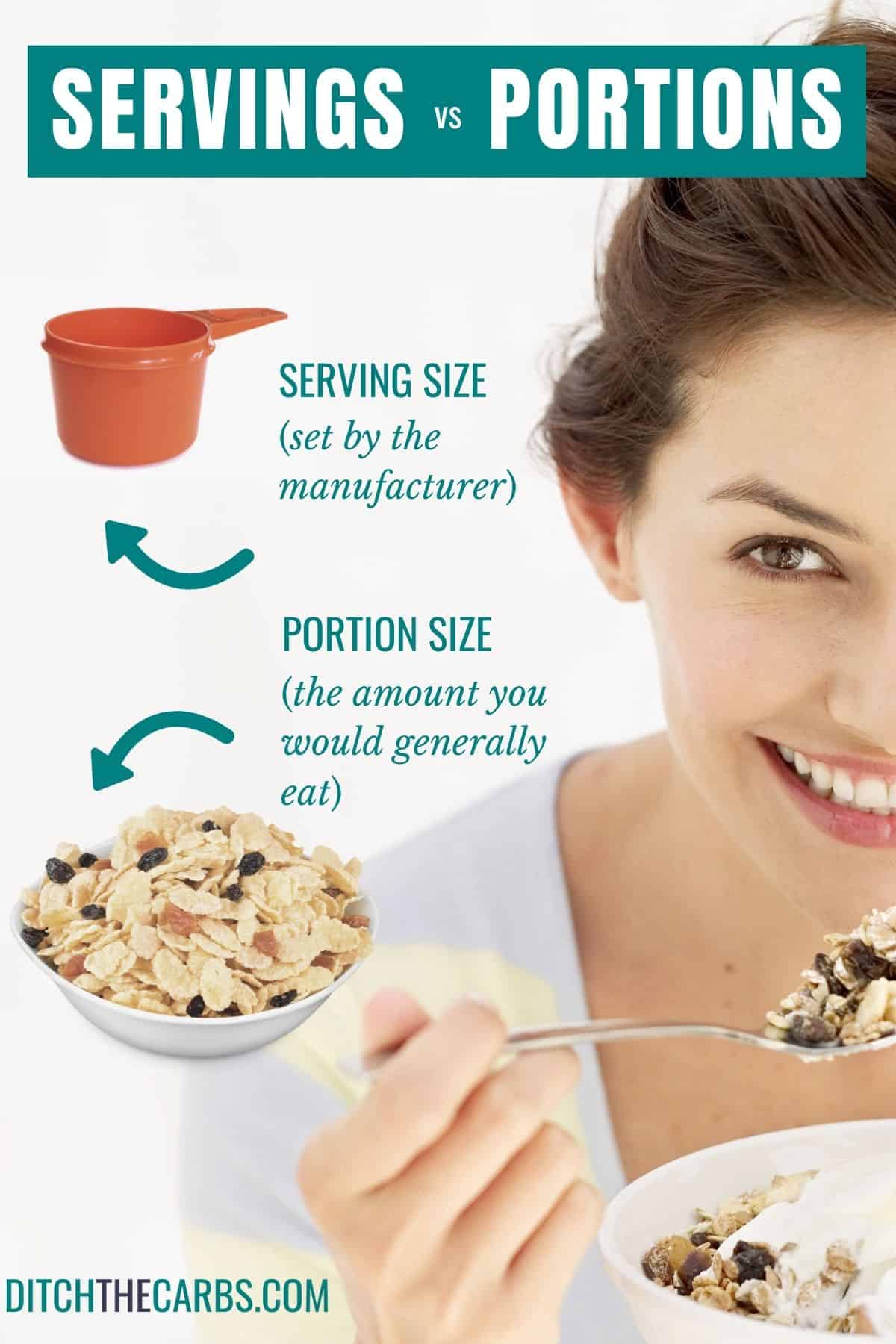
A nutrition label on a box of cookies will tell you what the serving size is, as determined by the manufacturer. This helps you know how many calories (or more importantly, net carbs) you are consuming based on how much they suggest as a serving size.
For example, sugary fizzy drinks will often show a serving size of 1 or 2 servings per bottle/can, but most people would consider the correct portion size to be one bottle/can per serving.
Granola may often say a serving size is 1/2 cup whereas the average woman would actually serve themselves up to 2 cups, and sometimes go back for second helpings. As you can imagine, the total calorie intake really adds up!
Manufacturers will often recommend a smaller serving size so the calories, saturated fats, trans fats, salt, and amount of sugar appear to be smaller and it will appear the box or packet contains a large number of servings. Confused? That’s what they want.
How can portion control help you lose weight?
Controlling your food intake and your macros, allows you to rely on your body’s fuel stores and burn body fat.
Portion control helps you lose weight by reducing your daily servings of whichever healthy eating plan you are following.
Low-carb and keto portion control – helps you to reduce extra carbs and makes sure you don’t overdo fats (a common mistake for keto beginners). If you are following the keto food pyramid.
Standard American Diet portion control – helps you to reduce calories, saturated fats, and salt if you are following a low-fat diet.
How to calculate macros

So how do you calculate your macros? By using a free macro calculator which will help you understand how many carbs, how much protein, and how much fat to enjoy each day.
The best free keto macro calculator will ask your age, gender, current weight, percentage of body fat, whether you want to lose weight or gain weight, and your activity level.
It will show you how many calories to consume, minimum grams of protein, maximum grams of net carbs, and maximum grams of fat. It’s a great way to get started with healthy eating.
Top 10 tips for portion control (+ bonus 10 more)
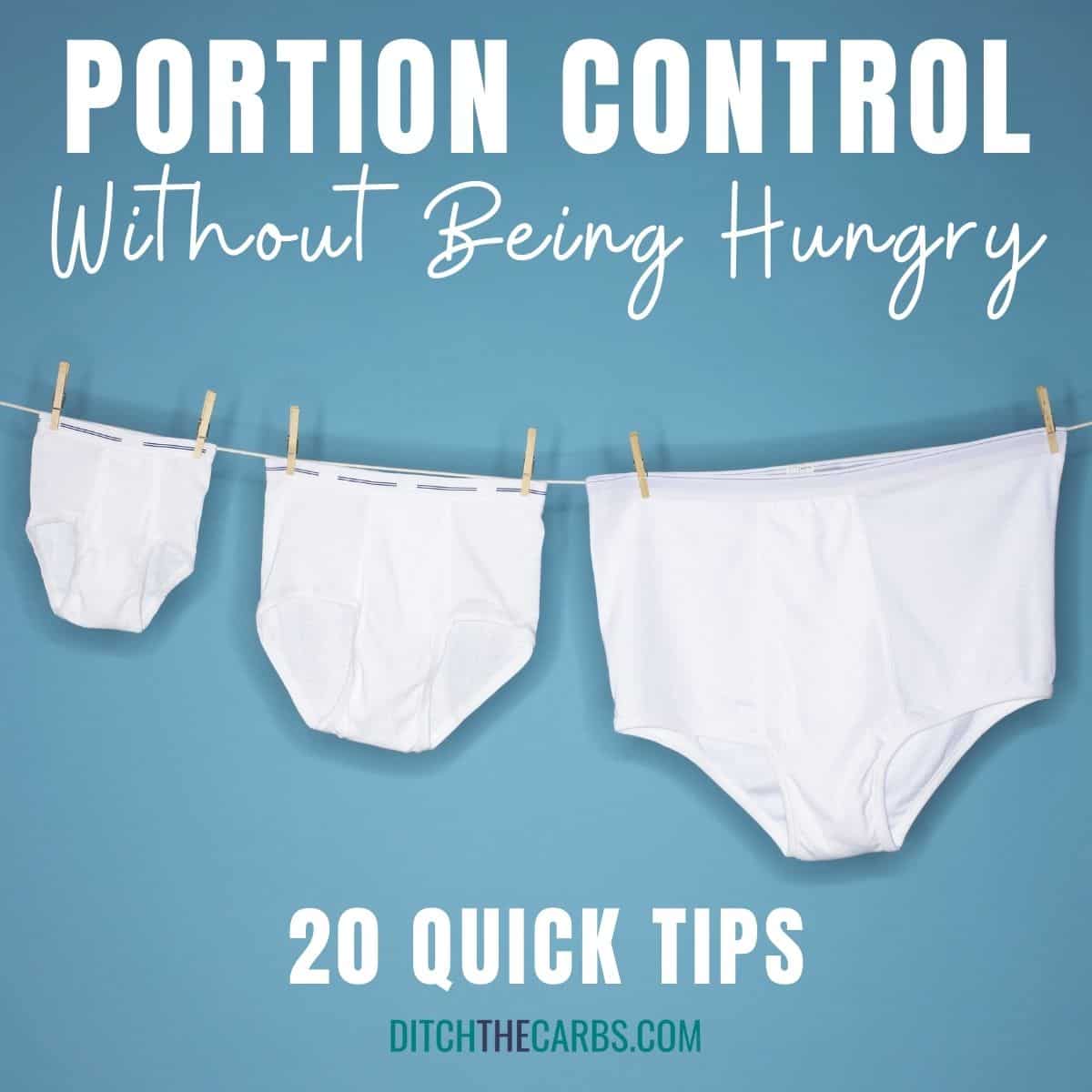
When starting your healthier diet you need to begin making healthy food choices. You can use a macro calculator which will help you decide how much meat, how much fat (not too little and not too much fat), and if you will count carbs or count calories.
1: How to portion control at home
Save calories by serving your meals on smaller plates, serving appropriately sized meals to each family member, put all leftovers away in the fridge or freezer to prevent you from going back for second helpings. Save the leftovers for an easy freezer meal.
2: How to portion control at restaurants/fast food
Look at meals restaurants serve. Are they large already?
Do not order side dishes, do not upsize any meal, do not order extra food, order half portions, or eat half and ask for the reminder to be bagged to take home. Every time you add extras or upsize, you’re adding unnecessary extra calories.
3: How to portion control snacks
Measure out the correct portion sizes for each snack into snack containers, portion control containers, or ziplock bags. When you want to eat snacks, take one bag and don’t go back for seconds. Most snacks are high-calorie foods and you can easily overdo and snacking is the most common reason for weight loss to stop.
4: Read food labels
Now you know the difference between portion sizes and serving sizes, you need to decide how much YOU want YOUR portion to be.
When you read a nutritional label, look closely at the ingredients, nutritional information, and serving size! Going for fewer calories? Try a half portion. Want to eat more calories? Up the portion size.
5: How to bulk up your meals
Drink a glass of water and add more leafy green low calorie and low-carb vegetables wherever you can to keep you full until your next meal. This helps with instant portion control and weight loss without feeling hungry. Extra vegetables will help you stay full but without the additional calories, extra carbs, and excess fat.
6: Eat slowly
Most people eat their food too fast and eat while watching TV or driving in the car. Begin to practice mindful eating rather than mindless eating or emotional eating.
When you reduce your meals you need to enjoy every single bite. Eat slowly. Portion control will be easier when you pay attention to how much you have eaten rather than being shocked when suddenly your whole bag of potato chips has disappeared.
7: Use a smaller plate
By using a smaller dinner plate (see below), you will serve less and not feel deprived with an equivalent smaller portion size served and lost on a large dinner plate. Fill your small plate with nutritious foods and avoid all the extra food that would normally fit on a regular dinner plate.
8: Meal plan
By eating to a schedule rather than when you feel hungry, will help you space out your meals and avoid unnecessary snacks. Meal planning is one of the most powerful ways to portion control for weight loss.
9: Eat more protein
Eating more protein will help keep you satiated until the next meal and will help stop your snacking. Choose lean protein if you are following a low-fat diet or fatty meats if you are on a keto diet.
10: Delay, don’t deny
If you are really hungry, delay eating for 5 minutes. Often your wave of hunger will pass and 5 minutes is enough time for you to reconsider if you are truly hungry, bored, emotional, or it’s mealtime so you feel obliged to eat.
If there is a snack or a meal that really doesn’t fit into your healthy eating plan, delay for 5 minutes then enjoy a small portion. If you always deny yourself your favorite treats, it can often lead to binge eating, overeating, emotional eating, or regular “cheat meals”
10+ More top tips for portion control:
Wear tight clothes – it will immediately give you the sensation of fullness rather than wearing your favorite sweat pants or yoga pants.
Measure portions – if you can’t eye-ball a correct portion size, use your kitchen scales, measuring cups, teaspoons, and tablespoons.
Prioritize protein – at every meal. Eat the carbs at the end only if you are still hungry. It’s often the garlic bread, rice (even brown rice), and pasta that keeps your going back for more and will trigger more hunger as your blood sugars drop.
Never eat standing up – yes, never eat on the run, never eat in the car, never eat standing up in your kitchen. These are all the occasions when you overeat without realizing it.
Drink your starter – order a broth-based soup instead of garlic bread or onion rings. The soup or broth will fill you up nicely and help prevent you from overeating your main meal.
Don’t drink your calories – no more high sugar smoothies full of fresh fruit. They are full of natural sugar which will trigger an insulin response and hunger later.
No distractions – stop watching TV and get off your phone. Pay attention to how delicious your meal is and register every single bite. The fewer distractions, the fewer calories you will eat.
Share your meals (or steal them) – out with a friend? Share a dessert (or steal a bite). Share a side dish (or steal 1 or 2 French fries) rather than ordering your own bowl.
Count every snack – even count the scraps of food you stole from your husband’s plate before you put it in the dishwasher. Stop nibbling while cooking.
Don’t put extra food on the table – serve then put away any leftovers for another day.
Chew sugar-free gum – chewing gum while making dinner is a great way to stop snacking and brushing your teeth after dinner is an easy way to mentally finish your food for the night. No more evening snacks.
Portion distortion (how your plate size affects your meal size)
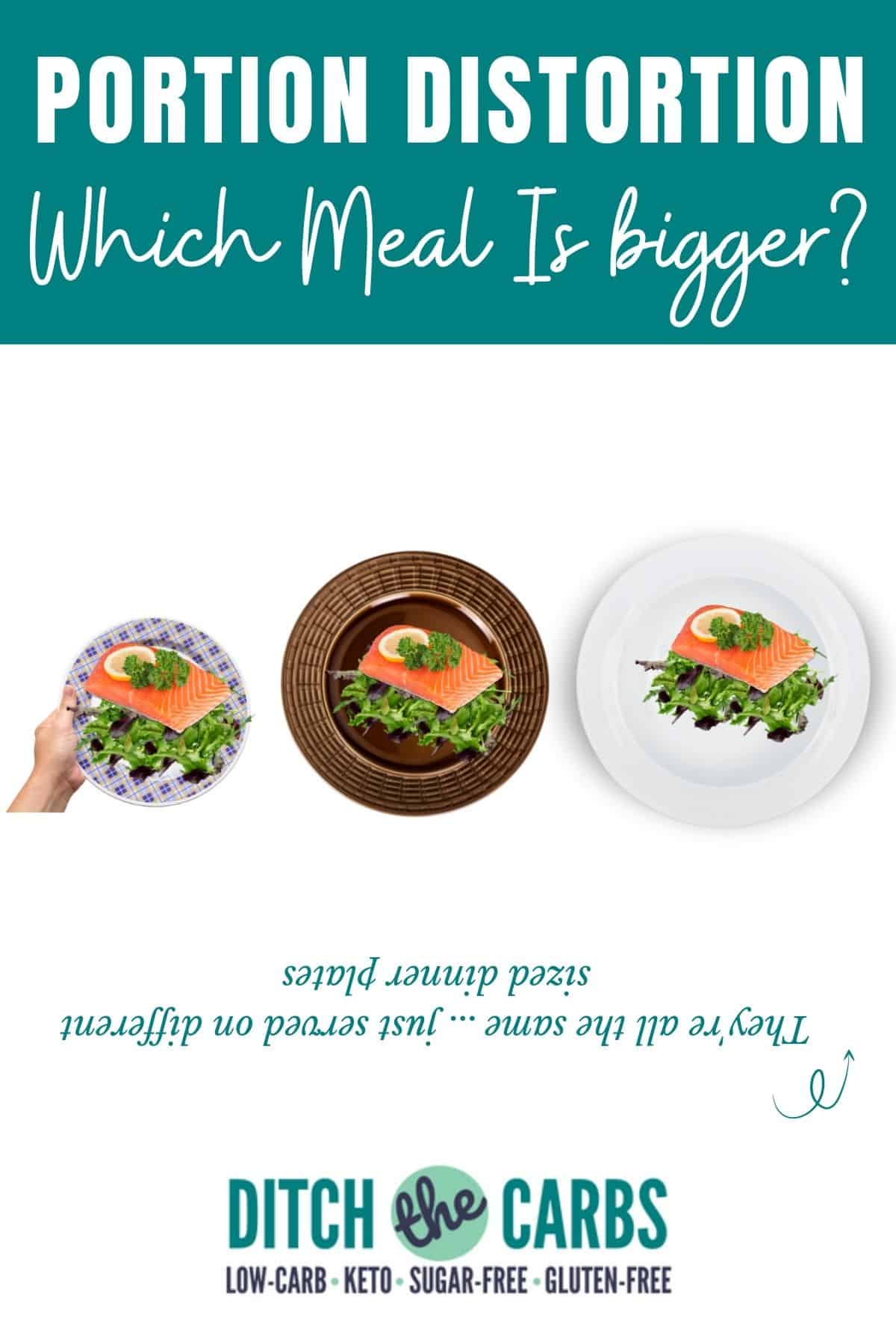
You probably know already, the bigger your dinner plate, the bigger meal you will serve yourself. Estimating portion control and finding healthy portion sizes using a large modern dinner plate is almost impossible.
With restaurants now upsizing everything, and junk food being sold in king-sized packages, it has become difficult to learn portion control and what is “normal”.
It’s no wonder people are struggling with unwanted weight gain from more calories!
Even our baking tins and muffin trays have supersized over the years No wonder it can be very confusing to know how much food we should be eating.
It is actually grotesque the size of food and drinks I see being consumed in some food halls and restaurants.
The solution is so simple. Get the correct portion size by using the correct sized plate!
Serving sizes (how they have changed over the past 20 years)
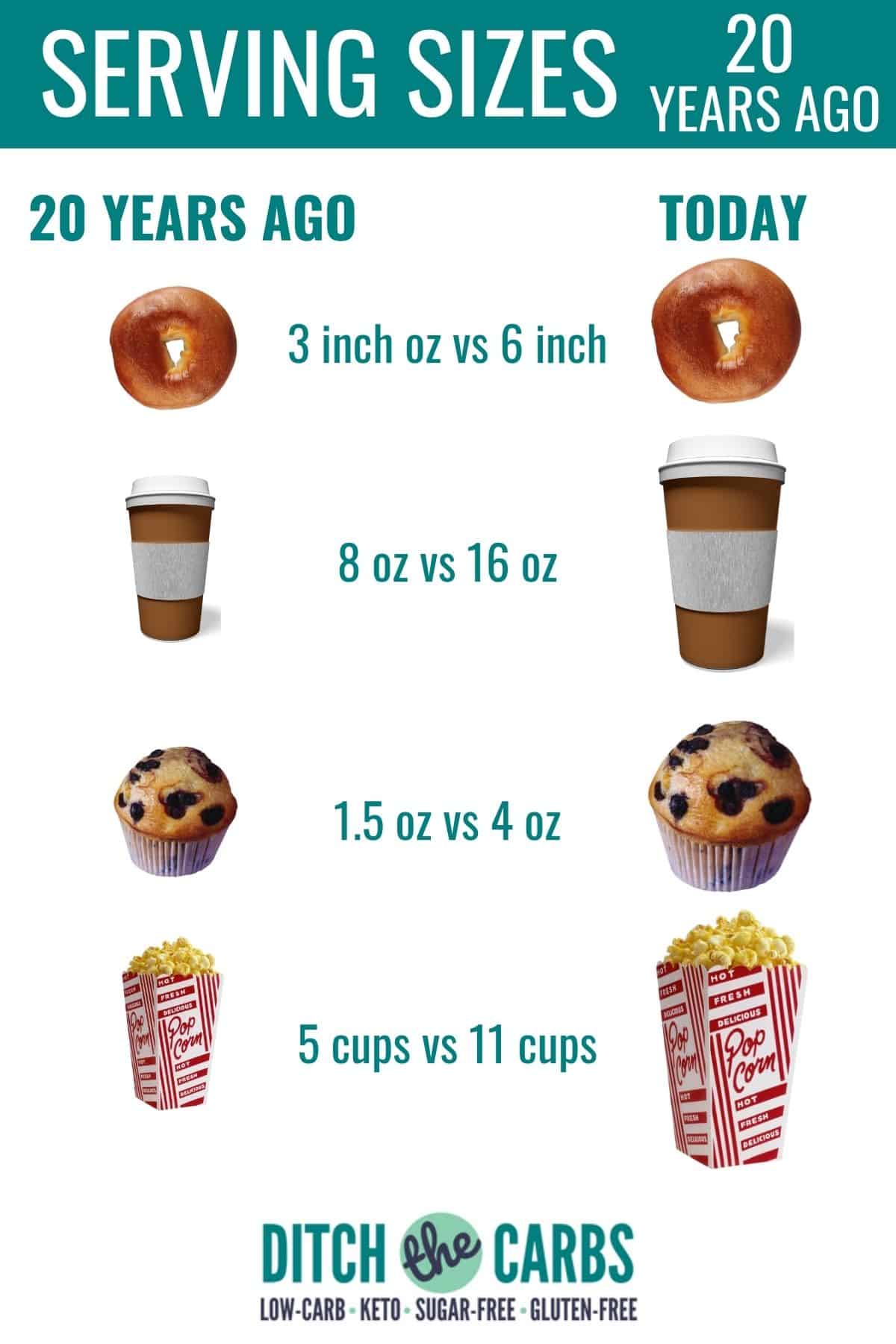
Now we know even dinner plates have changed over the past few decades, just look at what was considered a normal portion size from 20 years ago.
Meals at restaurants have been shown to “exceed serving standard serving sizes by at least a factor of 2 and sometimes 8-fold. Portions have increased over time; those offered by fast-food chains, for example, often are 2 to 5 times larger than the original size.” (1).
Here’s why understanding portion control is so challenging…portions keep changing! Here’s what you need to understand about the size of food now vs two decades ago.
20 years ago, you would have been served a 3-inch bagel, whereas now it has DOUBLED to an average 6-inch bagel. Coffee has been upsized from 8oz (236ml) to 16oz (473ml). Again, it has DOUBLED.
Low-fat muffin? Same thing, but worse. 20 years ago you would have gotten a 1.5 oz muffin, but now it’s 4 oz! They have almost tripled in size from 20 years ago. (2).
Now what this doesn’t tell you, is that the bagel is often served with sweet fillings more often than savory, the coffee comes with shots of syrup, and the muffin may be served with whipped sweetened cream.
No wonder it can be out of the question to get portion control right.
What does 30g carbs look like?
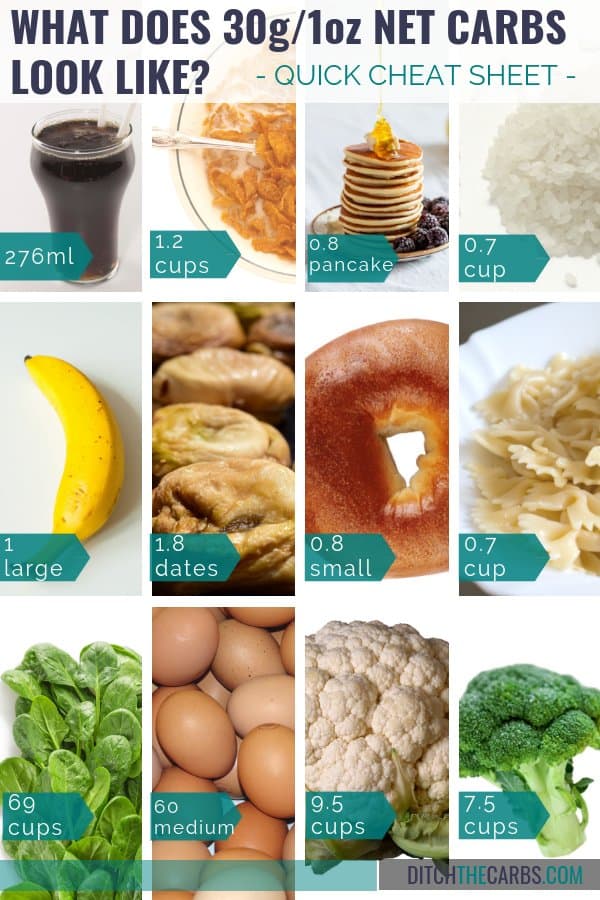
Since I believe more in watching carb count than calorie intake, I wanted to show you what 30g of carbs actually looks like. You’ll be surprised at just how unbalanced the “balanced diet” full of the “correct portion size” can really be!
Whether you are trying to lose weight or want to focus on healthy eating, this chart can be a stark visual reminder of how to ditch the carbs and choose nutrient-dense lower carb foods instead.
Why have 1.8 dates or a small glass of sugary fizzy drink (and be starving just half an hour later), when you could enjoy a healthy wholesome meal made with eggs, spinach and other non-starchy vegetables?
Add in some healthy fats such as olive oil or butter or cream cheese, and you have a brilliant meal that will keep you fuller for longer. Don’t forget the protein! You can choose lean protein or full fat.
If you are new here and want to know how to start low-carb, at the end of this post is a brilliant easy guide for you. There are so many health benefits to eating a healthy diet like this.
[charts are stated as cups as a more visual reminder of portion sizes on a dinner plate]
What does 30g protein look like?
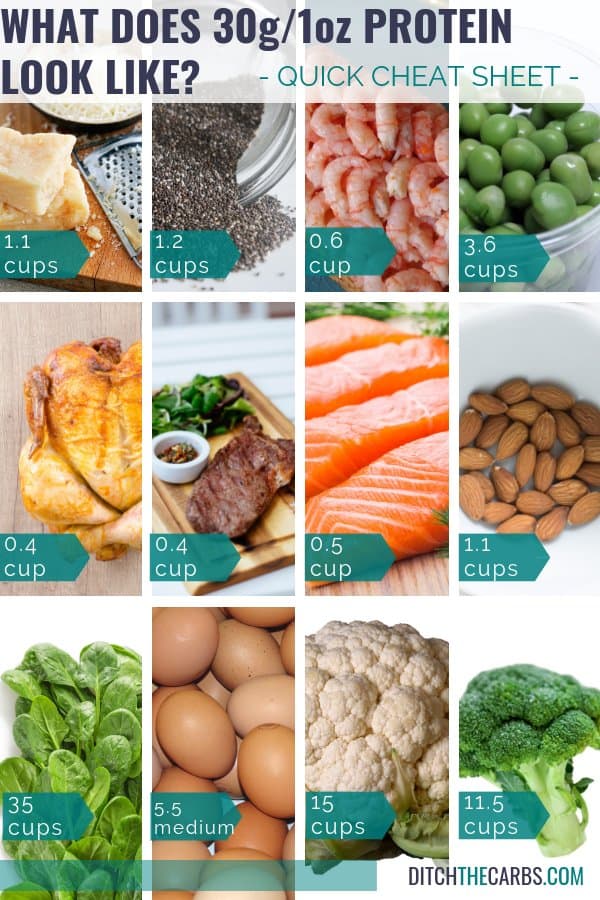
Now I bet you’re wondering how to portion control protein too? If you are eating out, serving sizes have doubled and you are eating from a large dinner plate, you may think dining on 2 chicken breasts is “normal” whereas some may consider 1 chicken breast to be correct.
When you live low-carb, you are moderate protein, not high protein. In another article, I will discuss how MUCH protein to have in a day, but it really depends on your situation. A bodybuilder may require more protein than someone who is sedentary.
This is just a visual guide as to how to estimate how much protein is in food.
[charts are stated as cups as a more visual reminder of portion sizes on a dinner plate]
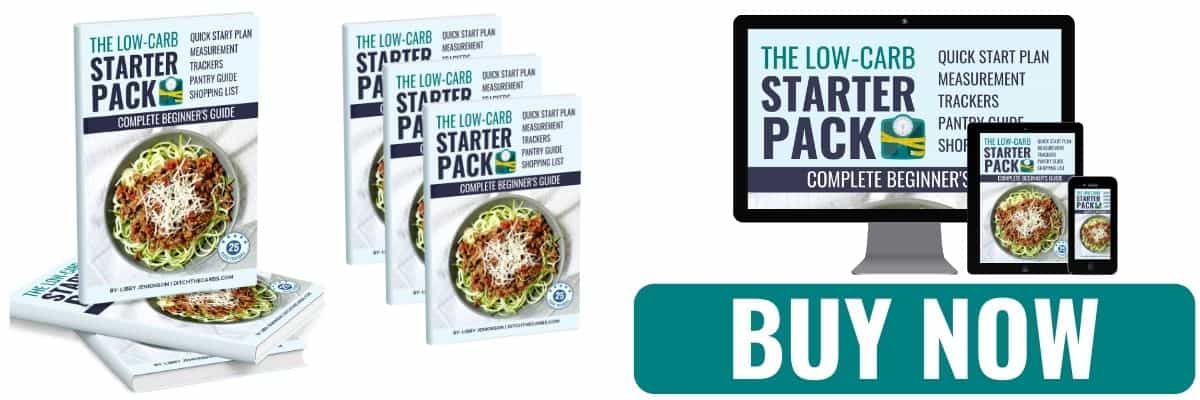
What if you could actually take control of
your health in just 10 days?
It’s not your fault you can’t lose weight as a woman over 40 even though you’ve likely tried literally everything. Your metabolism probably feels broken and your hormones are likely all out of whack.
But you can fix it all with ONE simple change: eliminate sugar. We make it super easy with daily lessons teaching you the science behind what makes us gain weight in our midlife and beyond! Are you ready to get started now?


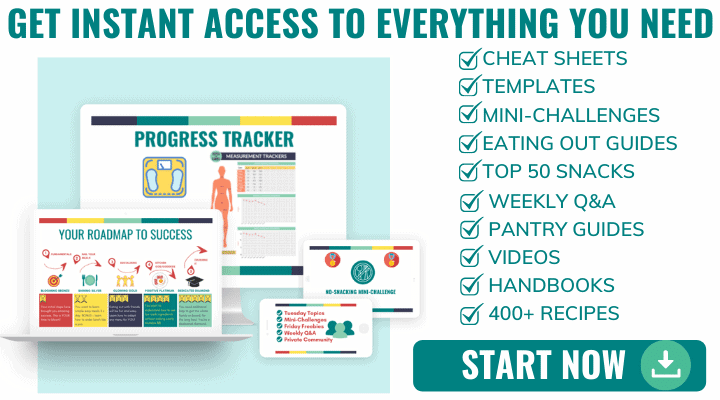







Hi Libby, great tips – thank you! But for top tip#2, don’t you mean the smallest portion will still be *bigger* than 20 years ago?
Whoops .. yes you are correct. I do need another pair of eyes when I write and edit my own work 😉
I find it odd we should have to concern ourselves with portion size when eating proper food (not junk). No other creature measures portions. As long as we are eating real food we should be able to eat until satisfied. I think the problem is we shouldn’t be eating 3 meals a day. No other creatures do that either except humans, and we didn’t always.
Hi Libby. While I really enjoyed the article, I’m still confused. I know it all depends on what you are eating, but I still don’t know portion sizes. For example, would you eat a cup or two cups or a half cup of, say spinach? Would you eat one forth pound, half pound or pound hamburger? On recipes I always see servings, but am never told the size of that serving. Can you help explain a little more in detail? Thanks, and love your recipes.
Great question. As a quick and easy guide, look at the serving sizes (and photos) I show for my recipes, that will help you from day 1, then you can adapt and amend them to your hunger, which will diminish the longer you live low-carb. Today I released a brand new macro calculator where you can calculate how much fat, protein and carbs you would like. There is no “one size fits all” as much as people don’t want to hear that. I don’t count anything any more, and you will get to that point, but at the beginning, it is useful to gauge how many carbs you would like to allow yourself, how much protein and how much fat (remember, fat is NOT a goal). Then from there, you can make some lovely low-carb recipes within your ranges. So you and I, for example, may want to enjoy completely different protein and carbs depending on our activity or lifestyle and health goals. This is why so many diets fail because they treat everyone the same, well, of course, that isn’t going to work, or be of any use in the long term. If you want to learn more, my 4-week course opens next week. You can join the waiting list here. The main point I wanted to get across here is to stop overeating. When I see portion sizes that are served in restaurants, it’s actually grotesque. No wonder it’s so hard to figure out how much to eat.
This web site is my inspiration, really fantastic style and design and Perfect subject matter.
I am still confused about portions , so what I’m doing is when I make your recipe I adjust for 2 serves, I live alone except for three dogs, then I just serve half of what I make and keep other half in fridge or freeze it. Am I doing things wrong ? Also I’ve searched your recipes for a really tasty cooked red cabbage recipe is that not a good vege to add to my list..
Cheers
Each recipe states how many servings the recipe will provide. For example, a dinner recipe might make 4 servings. If you then adjust the number of servings to 2, 4, 6,8 people, etc, the quantities of each ingredient will be recalculated, but the serving size and nutrition values will remain the same. You have just made more or fewer servings. I hope that helps 🙂